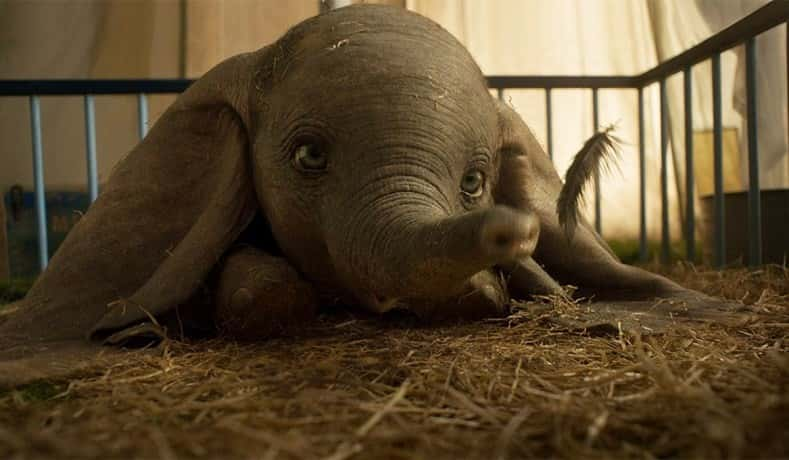Author: Cameron Fairchild
Header Photo: 2018 Disney Enterprises, Inc.
So the Jungle Book was a forgettable mess? Fine. Beauty and the Beast couldn’t help but add a magic teleporting book and the scourge Dan Stevens as its Beast? Okay… Aladdin looks like a TV show, and The Lion King is a drab, colorless, shot-for-shot CGI monstrosity. Great. At least Tim Burton, a visually distinct filmmaker, is behind the helm of Dumbo, an adaptation that drastically and potentially excitingly changes the structure of a 65-minute cartoon from 90 years ago, right?
…Is one of these ever going to be good?
Backed by Burton and a stacked cast of performers—including Michael Keaton, Danny DeVito, Collin Farrell, and Eva Green—each of whom seem like they’re in a different movie than everyone else, Dumbo can’t strike a consistent tone, and it can’t muster a screenplay worth creating an ensemble- especially this ensemble- of humans for. Major events have a habit of occurring off-screen, only for one of two equally-terrible child actors to thuddingly explain those events in the middle of action set-pieces. Character elements are dropped- in the case of the fake arm Farrell’s character wears for most of the film, literally- with little regard to why they were introduced in the first place. As Keaton’s one-note villain V.A. Vandevere strides into DeVito’s ramshackle carnival and offers to buy them out for Dumbo, he infers that DeVito’s character has always wanted a brother from a throwaway element of set design, only for that possible bit of psychological shading to never pay off or get brought up again. You will (not) believe an elephant knows how to operate a theme park’s electrical grid better than the man who ostensibly built it.
Some have written that Keaton’ character is a self-aware parody of Walt Disney, and Burton is using him to comment on his own complicity in the ruthless capitalist enterprise Disney began, but who cares? Keaton is so broad that the villain is indistinguishable from so many sneering, obvious bad guys, and is barely given any characterization outside of his clearly evil intentions. The film is so packed with uninteresting subplots and garish visuals that it can’t breathe long enough to say anything more substantive about Disney than, say, your average evil 1980s businessman can about capitalism. Like Keaton’s, each of the major performances suffer by the script, with the few members of the ensemble who aren’t overplaying their hand (Farrell especially) fading into the background without anything interesting to convey and the ones trying to enliven what little the script contains sticking out like a sore thumb (DeVito at times palpably reads as if he’s panicking to energize his castmates). The kids, who are essentially the film’s protagonists and unnecessary interpreter for the now-silent Dumbo, are kids, so of course they’re bad; that wouldn’t be as much a problem if anyone else was good here, and that’s just not the case. Still worse than them is Alan Arkin, who plays an even richer guy than Keaton for about eight minutes and (understandably) can’t be bothered to deliver a single line with a straight face. At one point the movie cuts to him as if he’s going to say something, and he awkwardly gapes at it for a second before it cuts away. It’s the only funny thing that happens in the film’s two-hour runtime.
Speaking of the eponymous elephant’s newfound silence, it’s important to note that as an adaptation, just about every decision made in changing the story falls entirely flat. With the circus troupe humanized, the selling of Dumbo’s mother feels forced- it’s hard to imagine Farrell’s upstanding Army vet wouldn’t intervene on her behalf. Transplanting most of the film to Dreamland, Vandevere’s theme park and the film’s toothless Disneyland parody, overstuffs the film with multiple poorly tangled storylines for the human characters which only get introduced and developed over the last 45 minutes (Eva Green’s morally dubious Colette suffers the worst here). Moreover, I can’t imagine kids are going to care about the unethical ramifications of corporate mergers even a little bit, and that conflict takes precedence over the film in a way that nothing that happens to the cute elephant it’s ostensibly about does. Dumbo gets lost in the shuffle, and its only when the film focuses on his magical flying routine that it achieves, in a handful of scenes, any sense of tension or narrative stakes. Dumbo looks alright as the CGI aberration in the center of a largely unanimated film, and his design is balanced well between one of Burton’s weird-looking sympathetic monsters and a traditional CGI Disney thing. Still, he barely appears in the movie outside of the scenes where he performs, and when he does appear the filmmaking occasionally slips into an unnecessary, glassy Dumbo-POV shot, overextending itself in an attempt to build empathy between audience and elephant.
An early indication of Vandevere’s villainy comes when he removes the safety net from the circus ring Dumbo is set to perform in. From the stuffed, expository script to the myriad condescending attempts to make absolutely sure its audience will understand what Dumbo is feeling, Dumbo feels like that net- unwilling to take risks. I wish it, and Disney as it continues to pump out uninspired remakes, would act more like Vandevere and rip that safety away.
CAMERON FAIRCHILD | Big Eyes? More like big ears! Big Eyes sucks too | KXSU Arts Reporter

